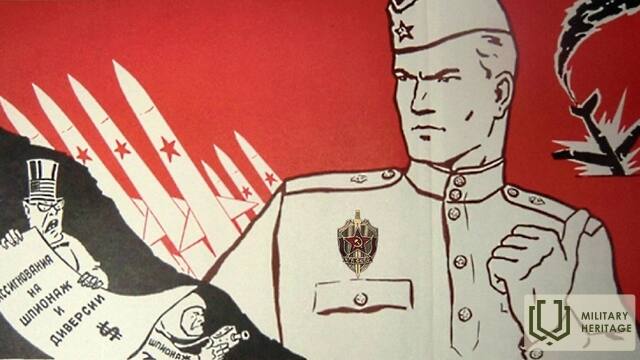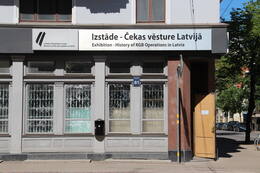Soviet double agents
IV Soviet Occupation, III National Partizans
In the early 1950s, the US intelligence service CIA began to play an increasingly important role in intelligence operations against the USSR, initially coordinating its activities with the British MI-6. The British at that time positioned themselves as experts in activities on the territory of the USSR, having both infiltrated agents and information. They also shared general information about the USSR with the Americans. All this information actually turns out to be Soviet counterintelligence disinformation.
Consequently, priorities in Soviet counterintelligence changed in 1951. Before that, the main direction of counterintelligence was the British and the USSR MGB 2. In the structure of the main administration, according to the Slavic alphabet, part 2A was counterintelligence operations against England, part 2B – counterintelligence operations against the USA, and part 2V – counterintelligence operations against Latin American countries.
On December 25, 1951, a reorganization took place, during which the letter designations were changed to numerical designations. The main direction of counterintelligence became the USA. Thus, in the 2nd Main Directorate of the MGB of the USSR, the 1st Division was responsible for counterintelligence operations against the USA, the 2nd Division for counterintelligence operations against England, and the 3rd Division for counterintelligence operations against the FRG. This arrangement remained in effect until the collapse of the USSR.
The USSR intelligence service had agents in both the British and American intelligence services, who leaked information to the USSR intelligence service and acted against the West. They were part of much broader measures implemented by the Moscow “center”, as a result of which specially prepared disinformation was “leaked” to the special services of Western countries. For these purposes, in the early 1950s, a fake Forest Brothers unit was even created in Latvia to demonstrate to British intelligence agents a “real national resistance movement”. Soviet counterintelligence managed to fool both the British and real national partisans, as well as the main opponent – the US CIA, which at that time directly launched operations in Latvia
More information sources
https://www.lsm.lv/raksts/dzive--stils/vesture/kgb-slepenie-arhivi.-spiegu-speles-latvija-cia-agenti-psrs-dienesta.a261845/
https://www.lsm.lv/raksts/dzive--stils/vesture/kgb-slepenie-arhivi.-spiegu-speles-latvija-patiesie-strikisu-raustitaji.a260177/
Related timeline
Related objects
Exhibition in the KGB Building "History of KGB Operations in Latvia"
The former USSR State Security Committee (commonly known as Cheka) building is open for visitors. Here chekists imprisoned, interrogated and murdered Latvian citizens who were considered opponents by the occupation regime. There is also an exhibit from the Latvian Occupation Museum on the activities of Cheka in Latvia. Guided tours of the prison cells, corridors, basement and courtyard are available. The house was built in 1911 and it is one of the most beautiful buildings in Riga. Called the ‘Corner House’ by the people, it was the scariest symbol of the Soviet occupation regime in Latvia, and also one of the pillars of power of the USSR. Cheka operated from the Corner House during the occupation from 1940 to 1941 and then again from 1945 to 1991. Tens of thousands of Latvians were affected by direct political persecution. The fight against enemies of Soviet rule continued also after World War II. Cheka’s approach towards its operation slightly changed after Stalin’s death. Physical torture was replaced by psychological terror. The majority of Cheka agents were Latvians (52%). Russians were the second largest group – 23.7%. 60.3% of the agents were not members of the Communist Party. 26.9% of the agents had higher education. The system was designed in a way to involve local people and thus have greater control over the society. Staff documents and service records are located in Russia. And these materials have not been made available to Latvian authorities and researchers.
Museum of the Occupation of Latvia
The museum exhibits the history of Latvia from 1940 to 1991, under the occupation of Nazi Germany and the Soviet Union. ‘House of the Future’ is a reconstruction and expansion project of the Occupation Museum designed by the well-known American Latvian architect Gunārs Birkerts as well as the new exhibit of the museum. The exhibit ‘History of Cheka in Latvia’ was created by the Occupation Museum and it is located in the ‘Corner House’, which is the former USSR State Security Committee (KGB) building. Latvian Occupation Museum was founded in 1993. It tells the long-hidden story of the fate of the Latvian state, nation and land under the occupation of two foreign totalitarian powers from 1940 to 1991. At the end of 2020 the museum had more than 70,000 different historical items (documents, photographs, written, oral and material evidence, objects and memorabilia). Museum specialists have recorded more than 2,400 video testimonials, making it one of the largest collections on occupation in Europe. The events that unfolded in Latvia, Lithuania and Estonia clearly show us what the nations had to endure under the two totalitarian regimes.
Related stories
Alfred Riekstins, nicknamed "Imants", dies as a result of betrayal by a Soviet double agent
Alfred Riekstins, a Latvian legionnaire, was recruited to work with the US intelligence agency, the CIA, after World War II.









